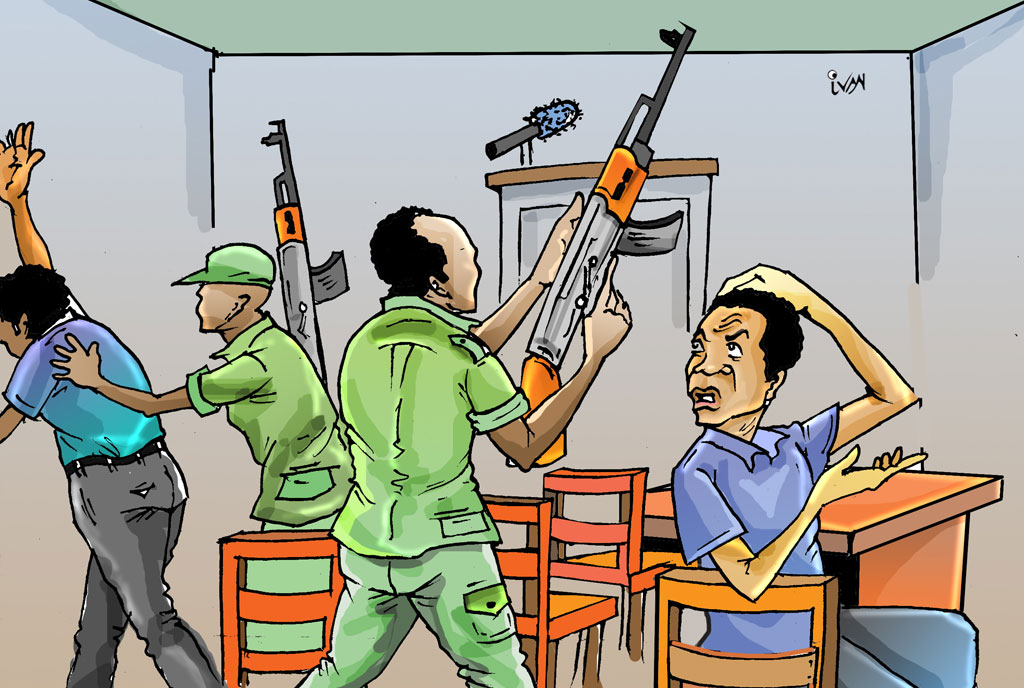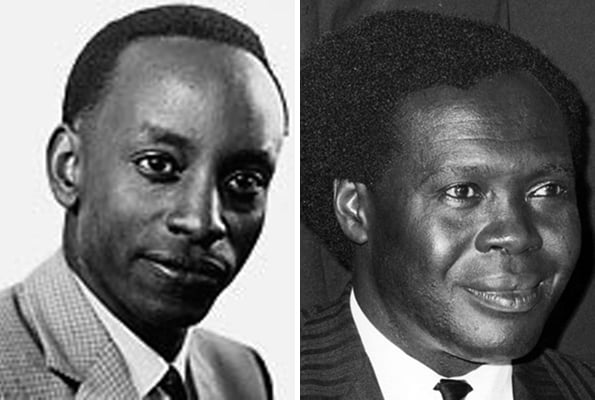Prime
Inside Ibingira’s plot to overthrow Obote – Part II

An illustration of security personnel arresting Cabinet ministers who were conspiring to depose prime minister Milton Obote. ILLUSTRATION BY IVAN SENYONJO
What you need to know:
- Last week, we looked at how former minister of Justice Grace Ibingira tried to seize control of UPC and depose his boss Milton Obote. In this article, we look at how for the former prime minister reacted.
Former prime minister Milton Obote, who had increasingly maintained silence over the boiling matter, was smartly laying his base for action. He skipped the February Accra Organisation of African Unity (OAU) conference to concentrate on rebuilding his home base. A series of tours and speeches strengthened his image in rural areas.
In Bunyoro, Obote had defeated the January attempt by Ibingira’s forces to take over the kingdom UPC chapter. The pro-Ibingira Munyoro minister of Labour in Obote’s government, George Magezi, had proposed a vote of no confidence motion against Obote in the kingdom. The motion failed by 10 votes, marking the crumbling clear of the “Bantu Group” in Bunyoro.
In Ankole, Obote directed his minister of Internal Affairs Basil Bataringaya, who immediately took over the kingdom’s UPC chapter, thus cutting off Ibingira’s home base.
In Busoga, also vice president Wilberforce Nadiope’s kingdom, Obote himself visited the kingdom and skilfully spoke with the subjects, hardly hitting back at Nadiope.
“I come not to bury Wilberforce, but to praise him,” he said.
Returning from his upcountry tour 11 days after Ochieng’s motion, Obote found Ibingira’s manipulation of the Cabinet and the matter of the probe into the alleged corruption too serious that he was unable to dissuade his ministers from proceeding with the investigation. As such, a concerted action had to be prompted immediately.
On February 22, 1966, five ministers were arrested on the instruction of Obote. They included Emmanuel Lumu, George Magezi, Balaki Kirya, Mathias Ngobi and Ibingira. They stayed in prison until Amin’s 1971 coup.
MP Daudi Ochieng, whose motion triggered the events, survived the arrest. He however, was immediately diagnosed with stomach cancer and sent to a London Hospital in the UK for treatment. He returned to Uganda but his condition soon deteriorated and died on June 1, 1966.
Suspension of Constitution
On February 24, 1966, relieving Edward Muteesa of his duty as president, Obote abrogated the 1962 Constitution, suspended the offices of the president and vice president and appointed himself as a provisional executive president.
On April 5, 1966, Obote was sworn in as president amid protest from Mengo. On May 21, nearly a month after Obote was sworn in, the Buganda government convened a meeting and gave Obote and the central government 10 days to leave Buganda soil.
The following day, Obote arrested several dozens of the main supporters of the Kabaka, including army commander Shaban Opolot.
At this time, a section of Buganda Kingdom loyalists staged protests in different parts of the kingdom, burning tyres, setting up barricades, stoning government vehicles, digging trenches across roads, and cutting off telephone wires.
Final showdown
During his autobiographical interview in 2004 with Andrew Mwenda from his exile home in Lusaka, Zambia, Obote said he was undecided on what to do about the boiling situation in Buganda and he decided to summon his Attorney General, Godfrey Binaisa, who also happened to be a Muganda, to seek his advice on the matter.

An illustration of soldiers storming Kabaka’s palace in Mengo, Kampala. ILLUSTRATION BY IVAN SENYONJO
In their discussion, Obote stated, Binaisa suggested the suspension of the 1962 Constitution and abolition of kingdoms.
“Abolishing the traditional kingdoms is like killing my first born son,” Obote told Binaisa.
“Your first born son is already dead, just go ahead and bury him,” Binaisa replied.
In the afternoon of May 23, 1966, Obote called for an emergency meeting at the presidential lodge in Kampala. It was to be attended by Defence minister Felix Onama, Internal Affairs minister Basil Bataringaya and his Inspector General of Police, Lt Col Wilson Erinayo Oryema.
He informed the meeting that the situation in Buganda had ceased to be a matter of civil concern, but a military one. A small unit of GSU, a paramilitary agency, was sent to the Kabaka’s palace in Lubiri to arrest him, but they were repulsed by armed kingdom loyalists.
Thus the situation proved a harder task which called for a bigger force with the command of better trained, tougher soldiers to crush the resistance. And as such, Obote telephoned Amin and ordered him to come over to the presidential lodge.
Amin arrived right away in an army jeep and in full military uniform. Obote then briefed Amin about the mission at hand, ordering him to take necessary manpower to attack the palace and arrest the Kabaka, along with his supporters.
The attack
According to John Eldard Kato’s book, The Eight Years of Tension, very early on the morning of May 24, 1966, Amin advanced with necessary equipment and manpower. However, the Buganda Kingdom loyalists who had got wind of the impending attack poured into Lubiri in large numbers to defend their king.
For several hours, battle raged on as the Buganda loyalists put up a substantial resistance. At 2pm, Amin’s troops retreated temporarily. It is written, Amin drove back to the presidential lodge and informed Obote that small arms were not helping the situation. As such, he needed a high calibre of arms. In response Obote ordered him to do his job with whatever guns he wanted to deploy. Amin drove back to the frontline and immediately there were a series of very loud bursts followed by a wave of very thick smoke billowing from the Lubiri palace. Coincidently, a downpour started.
“It rained so heavily that it inhibited visibility and the battle came to a total pause. This was an opportunity Muteesa seized to climb over the perimeter wall to escape,” Kato writes. He fled to Burundi where he boarded plane to London, UK. He was found dead in his London flat in November 1969.
At about 4pm Amin had successfully crushed the resistance, leaving heaps of dead kingdom fighters. He then drove back to the presidential lodge, armed with the Kabaka’s presidential flag and the ceremonial cap that marked him as the commander in chief of the Uganda Army.
He presented these to his boss as a sign of success. Kato says Amin was in such a jovial mood when he told Obote that he was yet to confirm whether the Kabaka was dead or had escaped as his troops were still checking through the debris.




